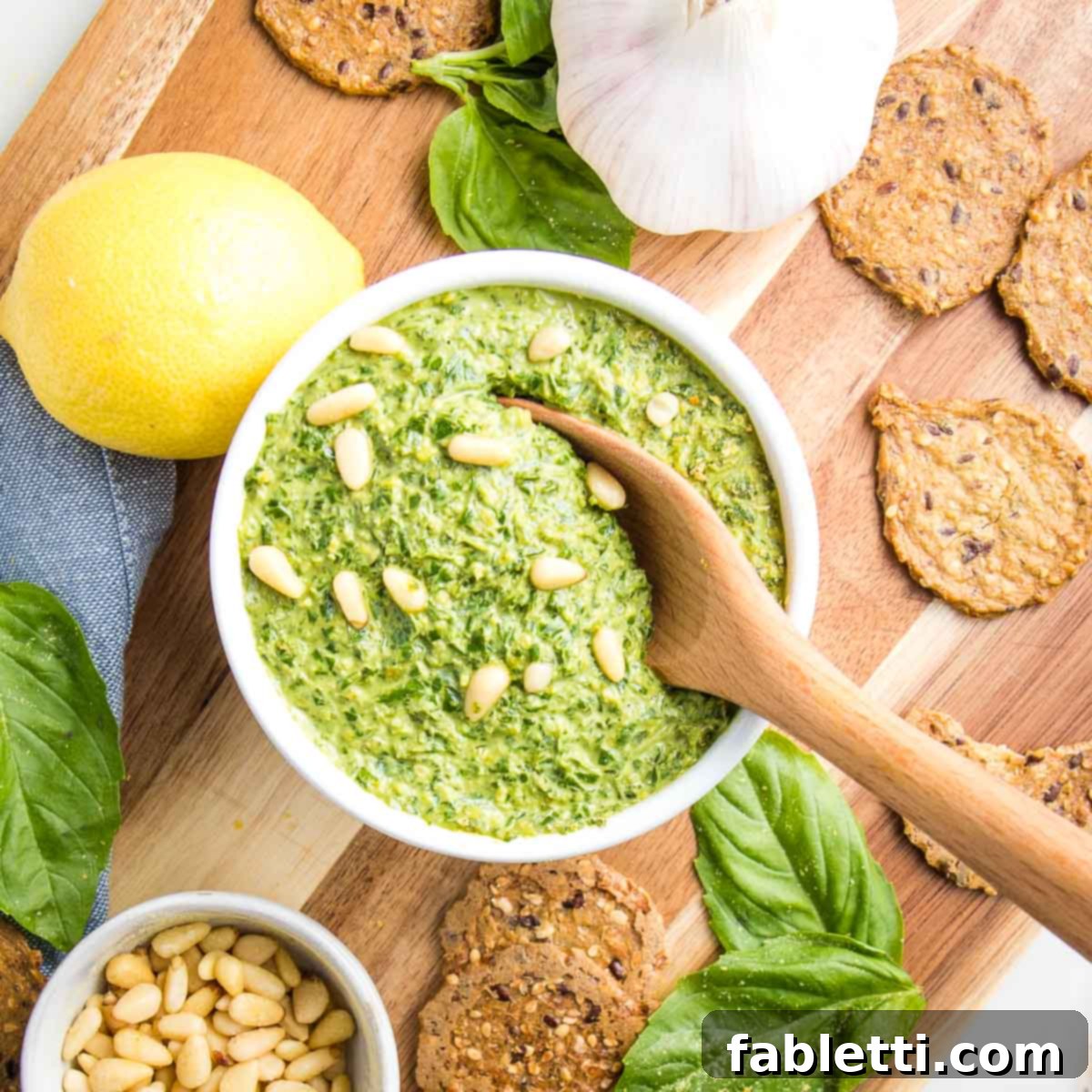Experience the Ultimate 5-Minute Vegan Basil Pesto: Your Go-To Dairy-Free Recipe! Transform your meals with this incredibly fresh, flavorful, and unbelievably easy homemade vegan basil pesto. Crafted in just five minutes, this vibrant green sauce is a dairy-free delight that promises to revolutionize your kitchen. Whether you’re meal prepping for the week or looking for a quick and healthy addition to dinner, this freezer-friendly pesto is perfect for enhancing pasta, spreading on pizza, drizzling over roasted vegetables, or simply enjoying as a dip. Get ready to embrace the unparalleled taste of garden-fresh basil in every spoonful!
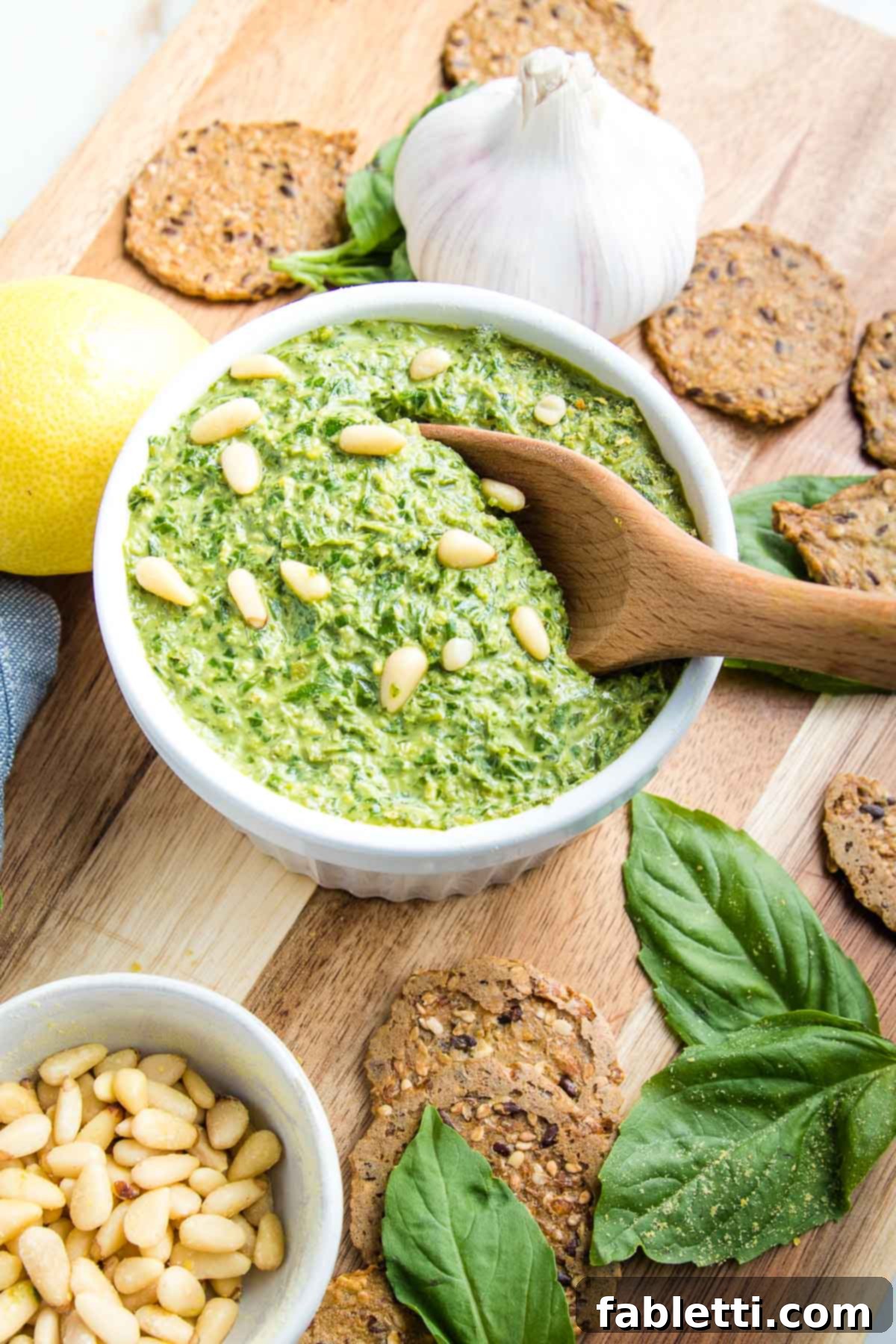
There’s nothing quite like the invigorating aroma and fresh taste of a homemade pesto. And when it comes to healthy eating, this dairy-free, vegan basil pesto truly stands out. Whether you’re nurturing your own basil plants in the garden or picking up vibrant bunches from your local farmers market, the rich, aromatic essence of fresh basil is the heart of this sensational sauce. This recipe captures that essence perfectly, offering a delicious and wholesome alternative to traditional pesto.
As an avid pesto enthusiast, I’ve explored a myriad of variations on my culinary journey. You might have already discovered my recipes for hearty kale pesto, peppery arugula pesto, a unique Dijon-infused pesto, and even an innovative carrot top pesto. While these creative twists offer exciting flavors, it was high time to perfect a classic: the traditional basil pesto. Rest assured, like all my recipes, this version is completely dairy-free, ensuring a taste that is nothing short of incredible. Prepare to be amazed by its creamy texture and robust flavor!
For all you pesto lovers out there, get ready to dive deep into the world of this versatile condiment. I’m about to share the ultimate guide to making the best vegan pesto, covering everything from its historical roots to the essential tips and tricks that will transform you into an expert pesto maker in no time. Let’s embark on this delicious journey together!
Why This Vegan Basil Pesto Will Become Your New Favorite

- **Incredibly Delicious & Completely Dairy-Free:** This pesto offers all the rich, savory flavor you expect from a classic pesto, without any dairy. It’s a perfect solution for those with dietary restrictions or anyone looking for a healthier alternative. The balance of fresh basil, zesty lemon, aromatic garlic, and nutty undertones creates a truly satisfying experience.
- **Blissfully Easy to Make in Just 5 Minutes:** Forget complicated recipes or lengthy preparation times. This recipe is designed for speed and simplicity. With a food processor or blender, you can whip up a fresh batch of vibrant pesto in literally five minutes, making it ideal for busy weeknights or impromptu gatherings.
- **Significantly More Economical Than Store-Bought:** High-quality pesto can be quite expensive at the grocery store. By making your own at home, you save money while enjoying a superior, fresher product free from artificial preservatives and unwanted additives.
- **Remarkably Versatile for Endless Culinary Creations:** This pesto isn’t just for pasta! Its adaptability makes it a kitchen staple.
- **Sauce:** Toss it with your favorite pasta for a quick meal, spread it as a flavorful base on pizza, or use it to elevate roasted vegetables like broccoli, zucchini, or bell peppers.
- **Dip:** Serve it as a delightful dip for crudités, crackers, or artisanal bread, making it a perfect addition to any charcuterie board or appetizer spread.
- **Spread:** Generously slather it onto wraps, sandwiches, or even fresh spring rolls for an instant flavor boost.
- **Marinade:** Use it to marinate tofu, tempeh, or plant-based proteins before grilling or baking for an explosion of herbaceous flavor.
- **Excellent for Meal Prep & Freezer Friendly:** Prepare a large batch and store it for future use. This pesto freezes beautifully, allowing you to have a ready-to-use flavor enhancer on hand for spontaneous cooking or planned meal prep. Say goodbye to food waste and hello to convenience!
What Exactly is Pesto? A Brief History and Modern Adaptations
The term “pesto” is generally associated with the iconic “pesto alla Genovese,” which hails from the picturesque city of Genoa in Italy. Traditionally, this vibrant green sauce was a humble yet powerful concoction of garlic, pine nuts, fresh basil leaves, coarse salt, and a hard cheese like Parmigiano-Reggiano or Pecorino Sardo, all emulsified with high-quality olive oil. The very word “pesto” itself originates from the Genoese verb “pestâ,” meaning “to pound” or “to crush.” Before the advent of modern food processors, authentic pesto was painstakingly crafted using a marble mortar and a wooden pestle, a method believed to extract the most intense flavors from each ingredient.
While the Genovese tradition remains a cherished culinary benchmark, the concept of pesto has beautifully evolved over time. Today, “pesto” often refers to a broad category of sauces where ingredients are pounded or ground into a paste. Modern interpretations embrace all types of fresh herbs and leafy greens, a wide array of nuts or seeds, and often include optional additions or omissions like garlic, cheese, or even oil. What truly defines a pesto now is its method of preparation—blending fresh ingredients into a versatile, flavorful paste. This allows for endless creativity, enabling you to add as much flavor as possible through various herbs and aromatics, making each batch uniquely yours.
Essential Ingredients & Creative Substitutions for Your Vegan Pesto

Crafting the perfect vegan basil pesto starts with understanding each ingredient and knowing how to adapt the recipe to your preferences or what you have on hand. Here’s a detailed look:
- Basil: The star of our pesto, fresh basil provides a distinct, sweet, and peppery flavor that sets it apart. You’ll need a generous amount for this recipe. If your basil harvest is a little short, don’t worry! You can easily supplement it with other fresh herbs to reach the required three cups. Fresh parsley offers a bright, herbaceous note, while a touch of fresh oregano or cilantro can add an interesting twist. For a more substantial filler, arugula works beautifully, contributing a pleasant peppery bite that complements the basil. While spinach is often used as a green in many recipes, it tends to be too flavorless and watery for pesto, diluting the vibrant basil taste.
- Pine Nuts: Traditionally, pine nuts are preferred for pesto due to their soft texture and buttery flavor, which blend seamlessly into a creamy paste. However, if pine nuts are unavailable or you’re seeking an alternative, there are many excellent choices. Cashews are a fantastic substitute, offering a similar soft texture and creating an equally creamy pesto. For a richer, more gourmet flavor, I’ve had incredible success with Marcona almonds, which, despite sounding counter-intuitive for a “soft” nut, produce a wonderfully complex and flavorful result. If you need a nut-free pesto, a combination of hemp seeds and pumpkin seeds is my top recommendation, providing a nutty flavor and good texture. Sunflower seeds also work well as a cost-effective, allergy-friendly option. Lightly toasting your nuts or seeds before adding them can deepen their flavor significantly.
- Garlic: Fresh garlic is crucial for that pungent, aromatic kick in pesto. For those following a low FODMAP diet or sensitive to raw garlic, you can still enjoy a garlicky flavor! Consider using garlic-infused olive oil, which imparts the essence of garlic without the potential digestive irritation. Alternatively, roasted garlic cloves offer a milder, sweeter flavor profile that can be delightful.
- Lemon: Fresh lemon juice and zest brighten the pesto, cutting through the richness and adding a delightful tang. Always zest the peel before juicing the lemon to capture those concentrated citrus oils, which amplify the overall flavor. If fresh lemons aren’t accessible, ¼ cup of bottled lemon juice can be used in a pinch. Another option is to use 1-2 tablespoons of white vinegar, which provides a similar acidic balance and a pleasant zing, ensuring your pesto isn’t flat.
- Extra Virgin Olive Oil: This recipe is already lightened with just ¼ cup of high-quality extra virgin olive oil, which adds richness and helps emulsify the pesto. If you’re looking to minimize or avoid added oils entirely, there are great alternatives. Simply substituting with water won’t yield the same depth of flavor, so I suggest using vegetable broth instead. To mimic the creamy texture typically provided by oil, incorporate 2 tablespoons of hemp seeds. I’ve made oil-free pesto this way many times, and truthfully, most people can’t taste the difference – it’s still wonderfully creamy and flavorful.
- Nutritional Yeast: For the longest time, I resisted this dairy-free secret weapon in my recipes. But nutritional yeast is an absolute game-changer, providing a fantastic “cheesy” flavor without any dairy. It’s an essential ingredient for achieving that umami depth in vegan pesto. You can find it at most grocery stores or easily order it from Thrive Market or Amazon. I use it so frequently that I always keep a large container on hand!
- Sea Salt: Salt is fundamental for enhancing and balancing all the flavors in the pesto. The amount you use is entirely up to your personal palate and taste buds. If you’re mindful of sodium intake, try making the pesto without it first, then taste and adjust. Adding a bit more garlic or lemon juice can naturally boost flavor without adding sodium. Alternatively, consider using a salt-free seasoning blend like Mrs. Dash to achieve a savory profile without the sodium.
- Pepper: I personally love the subtle, delicate heat that white pepper imparts, but black pepper is a perfectly acceptable and widely available substitute. For those who enjoy a more robust spice and an extra kick, feel free to sprinkle in some crushed red pepper flakes to taste after the pesto is blended.
Mastering Homemade Vegan Basil Pesto: A Step-by-Step Guide
You are going to be absolutely thrilled by how incredibly simple it is to make this pesto from scratch. Honestly, the process is so quick and effortless that you’ll wonder why you ever bothered buying store-bought pesto. Get ready for a revelation in your kitchen!

First, gather your ingredients and place the fresh basil leaves, pine nuts, nutritional yeast, lemon zest and juice, garlic, sea salt, and white pepper into the bowl of a food processor. A good food processor is key to achieving a smooth, consistent pesto. If you don’t have a food processor, a high-speed blender can also work, though you might need to stop and scrape down the sides more frequently. While it’s possible to make pesto with a traditional mortar and pestle, be prepared for a good arm workout and a fair amount of patience!

Begin by pulsing the ingredients until they are uniformly chopped into small, even pieces. This step is crucial before adding any liquid, as it ensures all the solid components are finely ground and integrated, preventing a watery or chunky pesto. Stop the processor as needed to scrape down the sides of the bowl with a silicone spatula, ensuring everything is thoroughly incorporated and nothing is left clinging to the edges.
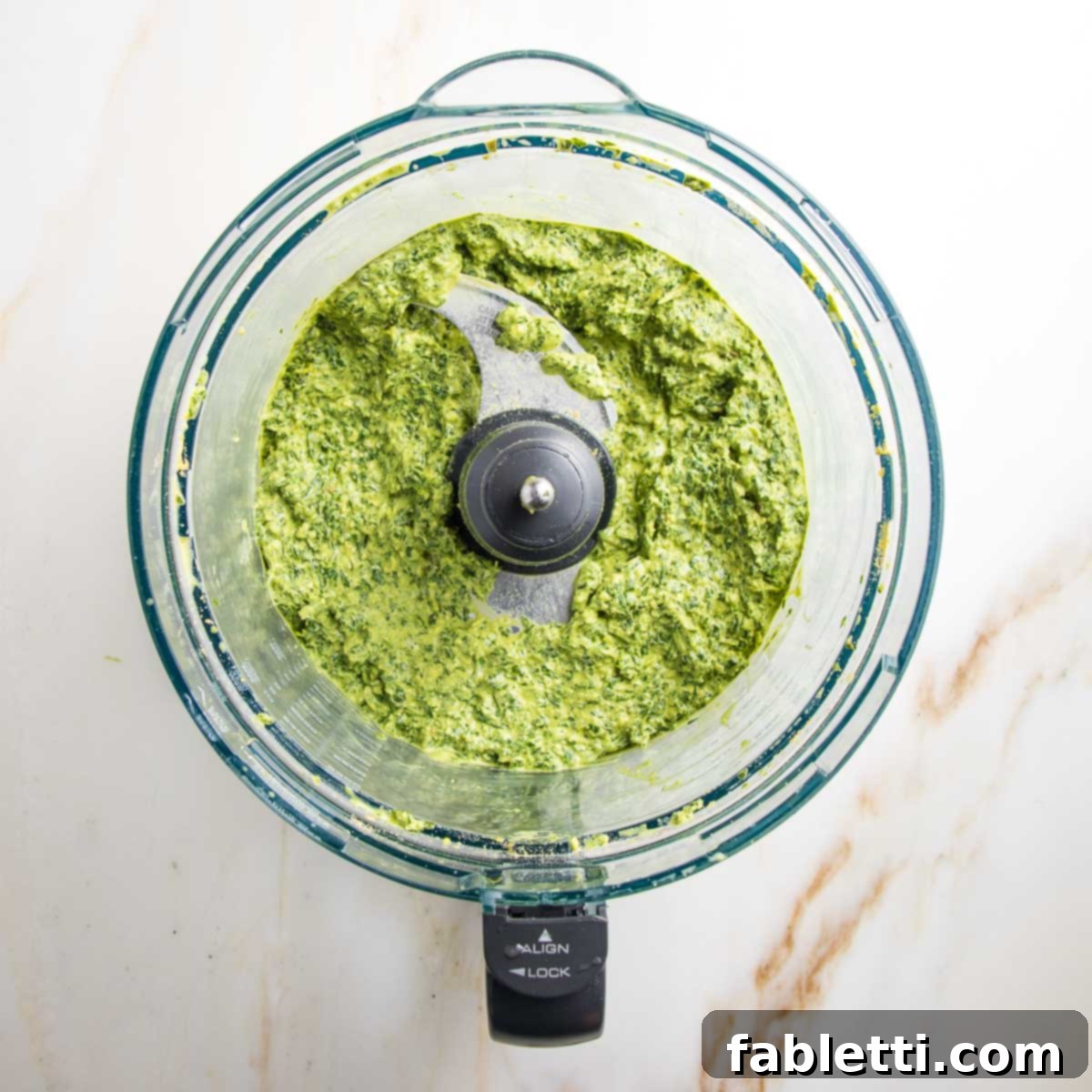
Once the solid ingredients are finely chopped, with the food processor running, slowly drizzle in the extra virgin olive oil (or your chosen liquid alternative, such as vegetable broth, if making an oil-free version). This gradual addition is key to creating a creamy, emulsified pesto. Continue to process until a smooth, vibrant green, dairy-free pesto emerges. At this stage, you have control over the final consistency. If you desire a thicker pesto, ideal for dips or spreads, use less liquid. For a thinner sauce, perfect for coating pasta or dressing salads, add 1-2 tablespoons of water or extra vegetable broth at a time until your desired texture is achieved. Always stop and scrape down the sides periodically to ensure a consistent blend.
Finally, taste your pesto and adjust the seasonings as needed. You might want a little more salt, a brighter hit of lemon juice, an extra dash of nutritional yeast for cheesiness, or a pinch of pepper for more warmth. Give it one last quick pulse to incorporate any added seasonings. Your homemade vegan basil pesto is now ready to enjoy, offering a burst of fresh flavor that will elevate any dish!
Debra’s Pro Tips for Perfect Pesto Every Time
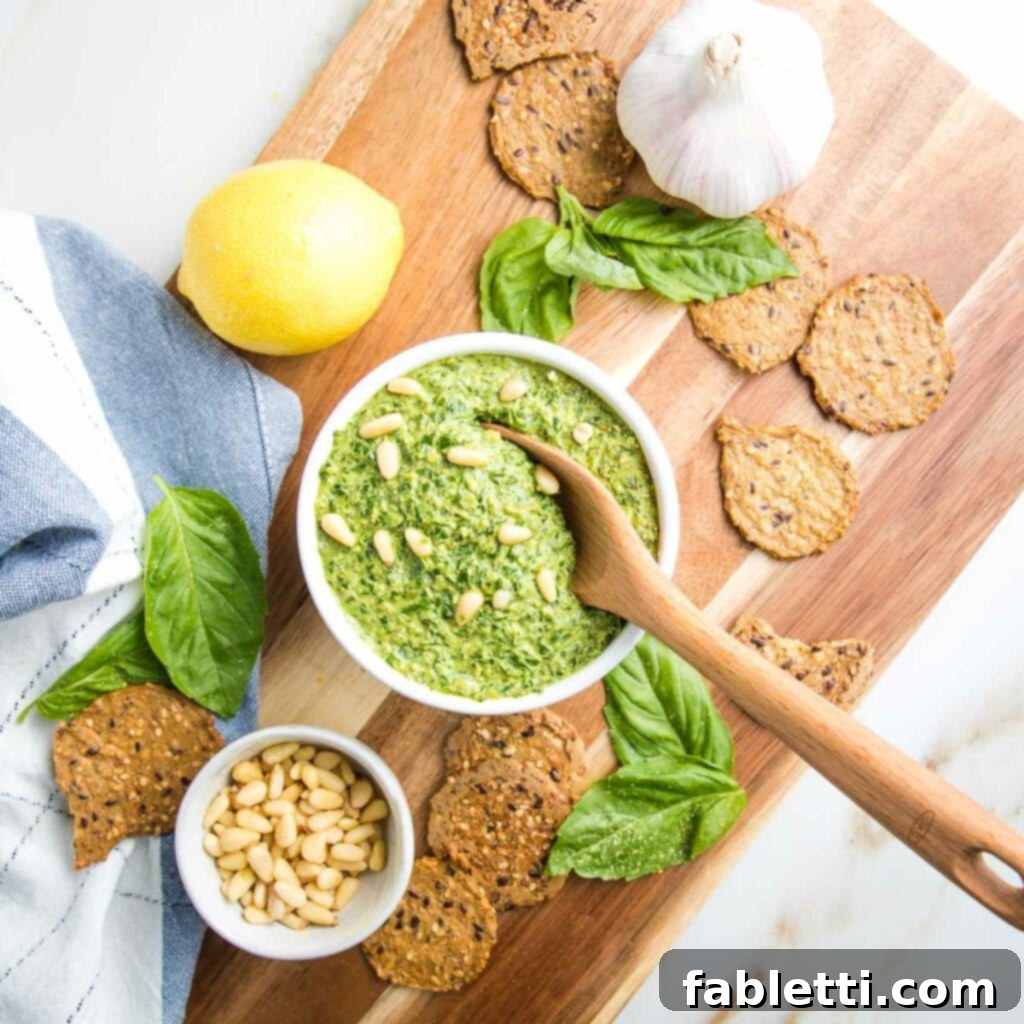
- **Double Down on Freshness: Make a Double Batch!** If you’re fortunate enough to have an abundance of fresh basil, don’t hesitate to make a double batch of this pesto. It’s incredibly easy to store and will thank you later. Freeze individual portions in ice cube trays. Once solid, pop the pesto cubes out and transfer them to a freezer-safe zip-top bag. These convenient cubes can be tossed directly into any sauce, soup, or stew for an instant and effortless flavor boost, cutting down on food waste and maximizing your fresh basil!
- **The Power of Pre-Pulsing:** Always ensure your solid ingredients (basil, nuts, garlic, zest, etc.) are uniformly chopped and finely ground before you start drizzling in any liquid. This critical step ensures a smooth, creamy pesto texture and prevents the final product from becoming too watery or having large, unblended chunks.
- **Creative Herb Combos:** Don’t have enough basil? No problem! Pesto is wonderfully forgiving. Feel free to use a combination of basil and other aromatic herbs like fresh parsley, oregano, or even a handful of arugula to reach the desired volume. Each addition will impart its own unique character to your pesto.
- **Say Goodbye to Browning: Smart Storage Secrets:** Pesto is notorious for oxidizing and turning brown on the surface when exposed to air. To keep your vibrant green pesto looking and tasting fresh, employ this simple trick: once your pesto is in its storage container, place a small piece of plastic wrap directly onto the surface of the pesto, pressing it down firmly to eliminate any air bubbles. Then, cover the container with a lid. This barrier prevents air from coming into contact with the basil, preserving its beautiful color and flavor for longer.
- **Grow Your Own: A Never-Ending Supply of Basil:** For the ultimate freshness and convenience, consider planting extra basil in your garden or growing a pot on a sunny windowsill. Having fresh basil readily available means you can whip up a batch of this delicious pesto whenever inspiration strikes, ensuring you always have the freshest ingredients at your fingertips.
- **Explore More Basil Wonders:** If you find yourself with even more basil than you can turn into pesto, try my Basil Balsamic Vinaigrette. It’s another fantastic way to utilize this fragrant herb and add a gourmet touch to your salads and dishes.
Finding Your Perfect Pesto: Customizing to Your Needs
The “best” pesto recipe is ultimately the one that perfectly aligns with your personal preferences, your ingredients on hand, and your specific dietary needs. Pesto is incredibly adaptable, making it a truly versatile culinary tool:
- What Ingredients Do You Have Available? The beauty of homemade pesto lies in its flexibility. Don’t feel confined to the exact ingredients listed. As detailed in the substitutions section, you can effortlessly adapt this recipe based on what’s in your pantry or garden. Whether it’s swapping nuts, changing up your greens, or adjusting the oil, there’s always a way to create a delicious pesto.
- What is Your Intended Use for the Pesto? The final consistency of your pesto can be tailored to its application. If you’re preparing a creamy pasta salad, you’ll likely want a slightly thinner, more emulsified consistency. For spreading generously onto crispy smashed potatoes, you might prefer a thicker, more concentrated flavor. When serving it with roasted vegetables or as a delightful dip for a charcuterie board, the consistency can also vary – thicker for dipping, thinner for coating.
- Are There Any Dietary Restrictions to Consider? One of the many reasons I adore making pesto from scratch is its incredible versatility in accommodating various dietary needs. It’s remarkably easy to create a delicious dairy-free pesto, oil-free pesto, or even a nut-free pesto without compromising on taste or satisfaction. My detailed substitution guide empowers you to tailor your recipe perfectly, ensuring you can whip up an epic batch of healthy pesto that suits everyone at your table.
More Sauces, Dips, and Spreads You Will Adore
- Baba Ganoush with Roasted Garlic and Tahini
- Green Tahini Sauce
- Easy Vegan White Bean Dip with Garlic and Herbs
- Creamy Tahini Caesar Dressing Recipe (vegan)
Did you know that leaving comments and rating recipes is one of the best ways to support your favorite food bloggers? If you made this recipe, please consider leaving a five-star rating below and sharing your thoughts in the comments. Also, don’t forget to share your delicious creations on Instagram by tagging me @dkhealthcoach and using the hashtag #debraklein – I’d love to see your pesto masterpieces!
📖 Recipe
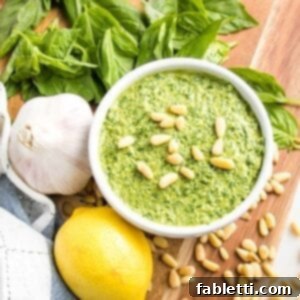
Vegan Basil Pesto
Rate this Recipe
Pin Recipe
Equipment
- Citrus Squeezers
- Microplane
- Food Processor
- Silicone spatula
- Measuring Cups and Spoons Set
Ingredients
- 3 cups 7.5 oz packed fresh basil leaves* (remove large stems before measuring)
- ¼ cup pine nuts*
- ¼ cup nutritional yeast
- 2 large cloves garlic
- 1 lemon zested and juiced
- ½ teaspoon sea salt
- ½ teaspoon white pepper*
- ¼ cup olive oil*
- 2-4 Tablespoons water*
Instructions
- Add the fresh basil, pine nuts, nutritional yeast, garlic, lemon zest and juice, sea salt, and white pepper to the bowl of your food processoror blender. Pulse until all ingredients are uniformly chopped into small, even pieces.
- Using a spatula, scrape down the sides of the bowl to ensure all ingredients are thoroughly incorporated. Process again if necessary to achieve a consistent texture.
- With the machine running, slowly drizzle in the olive oil (or the first ¼ cup of vegetable broth if making an oil-free version). Scrape down the sides once more and process until smooth. Add water (or more broth) 1 tablespoon at a time, until your desired consistency is reached. For a thicker dip, use less liquid; for a thinner sauce, add more.
- Taste the pesto and adjust seasoning as desired. You might want to add more salt, nutritional yeast for extra “cheesiness,” lemon juice for tang, or pepper for a subtle kick. Process briefly to mix in any added seasonings.
- Your homemade vegan pesto will stay fresh in the refrigerator for up to one week. To prevent the surface from browning due to oxidation, press a piece of plastic wrap directly onto the surface of the pesto before covering the container with a lid.
- For longer storage, freeze pesto in ice cube trays. Once frozen solid, transfer the cubes to freezer-safe zip-top bags. These individual portions are perfect for adding an instant flavor boost to sauces, spreads, or any recipe whenever you need it.
Notes
NUTS: I’ve previously substituted pine nuts with Marcona almonds, which yield a truly delicious result. For those with nut allergies or preferences, toasted pumpkin seeds or sunflower seeds are excellent nut-free alternatives that still provide a lovely texture and nutty flavor.
WHITE PEPPER: I prefer white pepper for its subtle heat. If you’re not a fan of spice, reduce the amount to ¼ teaspoon. For those who enjoy a bit more heat, taste the finished pesto and add a pinch (or more) of crushed red pepper flakes, then process again to incorporate.
FOR NO OIL PESTO: The total liquid needed (water and olive oil combined in the original recipe) is about ½ cup. To make it oil-free, you can either use more water or completely omit the oil. I highly recommend using vegetable broth instead of plain water to add more depth of flavor. Start with ¼ cup of liquid. Add another 2 tablespoons, process, then continue adding 1 tablespoon of liquid at a time until you achieve your desired consistency. Additionally, if you are omitting oil, add 2 tablespoons of hemp seeds to help compensate for the creaminess that oil typically provides.
Nutrition
Note
The nutrition calculations were done using online tools. To obtain the most accurate representation of the nutritional information in any given recipe, you should calculate the nutritional information with the actual ingredients you used. You are ultimately responsible for ensuring that any nutritional information is accurate, complete and useful.
